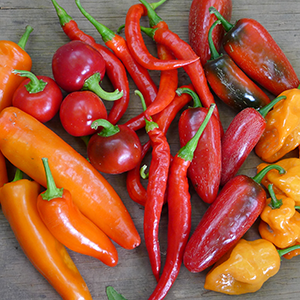
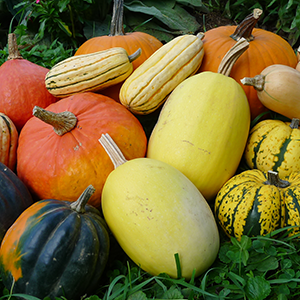
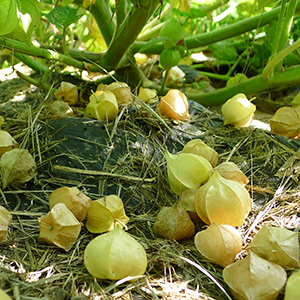

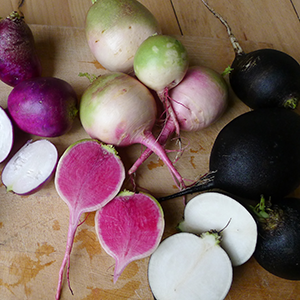
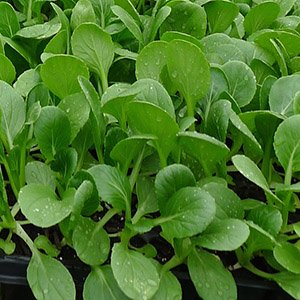
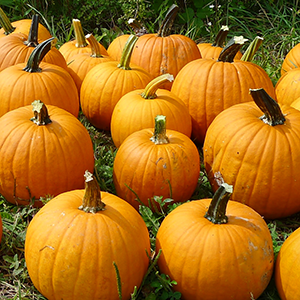



News and Notes | The Anchor Run Blog
Displaying a Single Post |
Show Recent Posts
December 16, 2018
So Long, Autumn
by Farmer Derek
So Long, Autumn
by Farmer Derek
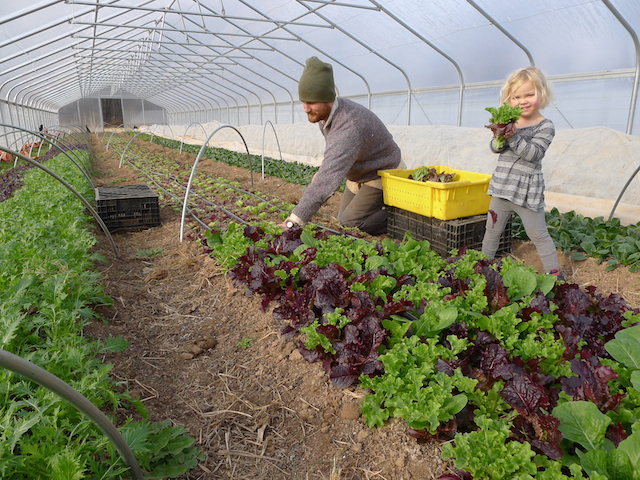
Harvesting some wonderful lettuce mix with a great little helper.
We welcome the Winter Solstice this week as seasons switch from autumn to winter. The darkest day of the year will come and go and then we'll appreciate lengthening days during the coldest time of the year. Fast forward to February when daylight eclipses the 10-hour mark and we'll be thinking spring, but for now we'll enjoy the holiday season and longer slumbers.
Besides spreading compost for a couple days this past week while the ground was dry and hard enough, I attended a Pennsylvania Association of Sustainable Agriculture (PASA) event that brought together advanced growers from the region to reflect on this past season. Much was mentioned of the calamitous nature of Mother Nature this year, it being one of the wettest or the wettest on record, and how the excessive moisture affected various crops and yield. Farmers are a relatively resilient group, with this season being perhaps the toughest test yet for this cohort of advanced growers who have anywhere from 10 to 30 years of growing experience. Most growers there were from small family owned produce farms or businesses that predominantly sell directly to consumers through a CSA or farmers market. Many also sell produce to restaurants and wholesale. Most farm organically and many are certified organic.
In addition to the beneficial feeling of camaraderie that surrounds this similar group that shared many of the same struggles during this season, I wanted to be able to leave the meeting with some valid insights into ways to improve our farm as we move forward into less predictable and more extreme weather. There are many factors that affect crop health but soil type probably has the greatest influence during a wet year. Soils that drain more quickly performed better than those that do not. Size of an operation also seemed to determine outcomes. Bigger producers and growers who require more time for field work and rely solely on mechanical/machine means for field preparation and cultivation struggled to stay on schedule. Crops couldn't be planted and those that got in were quickly outcompeted by weeds. Conversely, farmers who manage a smaller land area, focus on efficiencies, have diverse crops, and try to maintain output rather than continually expand seemed to weather the weather slightly better this year. Many growers mentioned the desire of scaling back to achieve a higher level of efficiency and control.
So what about our little CSA-only farm? Overall this year I think we held up okay. Our worst season for growing was the fall. It was an extremely wet time period but also unfortunately most of our plantings were concentrated in areas of the farm that have soil that doesn't drain that well (we have at least three soil types on the farm). Some crops grew well there including leeks, beets, later plantings of hakurei turnips, endive, dandelion, and lettuce mix. Crops that underperformed there included broccoli, cauliflower, cabbage, and Brussels sprouts. Spring and summer weather was almost as wet as the fall but the sun and heat helped crops through. Warm wet weather is much better than cold wet weather for our crops. Certain yields were down enough that warranted cancellation of the Winter CSA in order to make sure we had enough produce for the final month of the Main Season as well as the entirety of Late Fall. Good performers this season included strawberries, raspberries, blackberries, peas, heirloom and hybrid tomatoes, sweet peppers, summer carrots, cucumbers, zucchini, sweet potatoes, beets, onions, and garlic.
Because next year we won't be able to control the weather any better than this year we'll continue to do the little things that have allowed our operation to overall succeed during extreme weather events. We'll also consider investing in big capital and infrastructure improvements for longterm stability. We'll continue to embrace farming efficiently by maintaining our current membership size so that our land footprint remains consistent. Importantly, we'll prepare our fields for growing by taking advantage of dry weather windows to give us planting space for the next 3 or 4 weeks of planting (in case the soil remains unworkable for that long). We'll make raised beds so plants don't drown. We'll maintain or enhance crop diversity. We'll cultivate using manual means such as the omnipotent oscillating wheel hoe. We'll handweed when absolutely necessary with the help of our membership. We'll address drainage issues by slightly adjusting bed slope so water flows out of the field. We'll add contour buffer strips, waterways, and diversions to thwart a deluge. We'll sow cover crops whenever possible to minimize erosion. Additional longterm investments will be made with the construction of high tunnels.
This year was full of extreme rainfall events. It might be an anomaly, it might not be. We'll be ready for next season no matter what. Thank you for your support (and sorry this note is so long, I am guilty of overthinking)!

POSTS BY TYPE
POSTS BY MONTH

